Showa Day: Let’s Get Retro!
The Shōwa (昭和) era refers to the period of Japanese history corresponding to the reign of Emperor Shōwa. This lasted from December 25, 1926 until his death on January 7, 1989. The longest single reign in Japanese history thus far, and one that itself had several ‘eras’.
The early decades were full of political upheaval, conflict and struggle leading into the second world war. The postwar period saw a near-total reversal as a pacifist country rebuilt itself. This culminated in Japan becoming one of the most successful and modernized countries on earth by the end of the 1980’s.
The Heisei era that followed Shōwa was a period of relative peace, albeit economic stagnation after the 1980’s “bubble” burst. For the generation that came of age during this time, the Shōwa era offers a glimpse of another time altogether. And, especially when it comes to the later decades of Shōwa, it was a time of optimism. Japan grew to become an economic and cultural powerhouse. And, almost all the formations of modern popular culture find their roots during this time.
Go Retro!
Interest in this age has only grown into a full-fledged “movement” of sorts, akin to the nostalgia for earlier decades in America (once it was about 30 years old, the 1980’s seemed to become the coolest thing ever). The term “Shōwa Retro” (昭和レトロ)has gained popularity and become a catch-all for anything related to the ‘good old days’ of Japan.
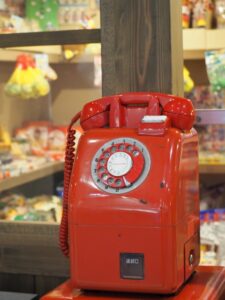 The core of Shōwa Retro is from around 1955 to 1974 (the Showa 30’s & 40’s), a period when the modern concept of Japan really began to take shape. Things we take for granted now like refrigerators, color television and the Shinkansen were brand new and exciting. Japan had a presence on the world stage during the 1968 Olympics or the 1970 World Expo.
The core of Shōwa Retro is from around 1955 to 1974 (the Showa 30’s & 40’s), a period when the modern concept of Japan really began to take shape. Things we take for granted now like refrigerators, color television and the Shinkansen were brand new and exciting. Japan had a presence on the world stage during the 1968 Olympics or the 1970 World Expo.
Cultural institutions in film, TV, comics and other entertainment began during this time as well. Shōwa Retro can go back earlier to the truly old-timey 1920’s & 30’s, or extend all the way into the late 70’s and 80’s (after all, those years saw the rise of video games, which have a retro movement all its own). But the hardcore aficionados will point to the late 50’s, 60’s and early 70’s in particular as being where it’s at.
The Taste of Shōwa
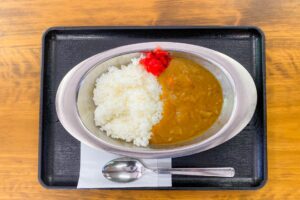 One area where Shōwa Retro does go all the way back to the past though is with food. If you ever find yourself going to a buffet or kitschy diner in Japan, it may be advertised being “Shōwa Retro”. You can expect to find a lot of foods that have become staples of the regular Japanese diet, but weren’t always. Think Napolitan spaghetti or Omurice. Generally, anything 洋食 (yōshoku or western dishes) that gained (or regained) popularity in the 1950’s and 60’s falls under the Shōwa Retro banner.
One area where Shōwa Retro does go all the way back to the past though is with food. If you ever find yourself going to a buffet or kitschy diner in Japan, it may be advertised being “Shōwa Retro”. You can expect to find a lot of foods that have become staples of the regular Japanese diet, but weren’t always. Think Napolitan spaghetti or Omurice. Generally, anything 洋食 (yōshoku or western dishes) that gained (or regained) popularity in the 1950’s and 60’s falls under the Shōwa Retro banner.
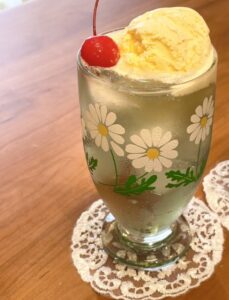 One such example is Japanese-style curry. Its origins lie in the Meiji era, and the Taishō era is when it became a popular dish for the average citizen. But the modern concept of “old school” curry is synonymous with Shōwa- the big metal plate of curry & rice screams that “good old days” sentiment that is Shōwa Retro.
One such example is Japanese-style curry. Its origins lie in the Meiji era, and the Taishō era is when it became a popular dish for the average citizen. But the modern concept of “old school” curry is synonymous with Shōwa- the big metal plate of curry & rice screams that “good old days” sentiment that is Shōwa Retro.
Cream Soda is a more direct example- it began in the 1970’s in Japan. Although, it’s not the same thing as what you might call cream soda in other parts of the world. Japan’s cream soda is melon-flavored, and the name comes about due to the tradition of serving it with a scoop of vanilla ice cream. Makes sense!
Enjoy Shōwa Retro!
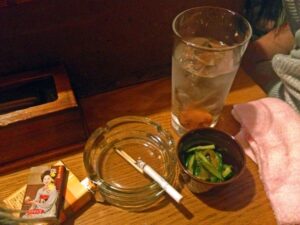 Shōwa Retro manifests itself in everything from fashion to architecture. At its heart, it’s an appreciation of all things nostalgic and retro, though not so old that they’d be considered ancient history (yet!) With the 1970’s now becoming half a century old though, it won’t always be that way. But we think it’s safe to say there will always be an appreciation for the past.
Shōwa Retro manifests itself in everything from fashion to architecture. At its heart, it’s an appreciation of all things nostalgic and retro, though not so old that they’d be considered ancient history (yet!) With the 1970’s now becoming half a century old though, it won’t always be that way. But we think it’s safe to say there will always be an appreciation for the past.
To honor of the late Emperor’s birthday, Shōwa Day is an annual holiday held every April 29. Shō means “shining” or “bright”, and wa means “peace”, signifying the “enlightened peace” that the citizens are to receive. While that usually just translates to “a day off” for most, take this year’s Shōwa Day to appreciate something retro. Visit a place like Shibamata and enjoy the food, culture and nostalgia of a bygone age!
Images:
Cover Image: 砺山さん on PhotoAC
1: potecoさん on PhotoAC
2 黒部五郎さん on PhotoAC
3 まろー17さん on PhotoAC
4 はなたれ君さん on PhotoAC
All other content provided by the original author.
When we say ”Japan”, the first things that come to mind are sushi, sakura and Mt. Fuji. So whenever a friend or relatives comes to visit me here in Tochigi, I always recommend coming to Ashikaga Flower Park. You can visit year-round, and there’s enough there to make second or third-time trips worth it too!
Sakura Season
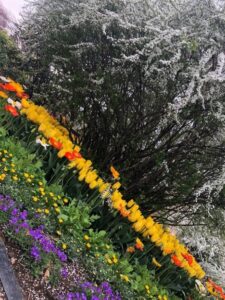 Sakura or cherry blossoms usually bloom during the end of March through April. You should always check the Japan’s Sakura forecast for this. This year, the sakura bloomed earlier than expected. At the time of this writing, sakura are already in full bloom, as well as other flowers. Especially towards the end of sakura season, you can see roses in many colors begin to bloom. A visit during this period is 800 yen for adults, and admission for 3 years old or below is free.
Sakura or cherry blossoms usually bloom during the end of March through April. You should always check the Japan’s Sakura forecast for this. This year, the sakura bloomed earlier than expected. At the time of this writing, sakura are already in full bloom, as well as other flowers. Especially towards the end of sakura season, you can see roses in many colors begin to bloom. A visit during this period is 800 yen for adults, and admission for 3 years old or below is free.
Wisteria Season
 While sakura season is a popular time to visit Ashikaga Flower Park, in truth wisteria season is by far the most popular. Wisteria are known as fuji in Japan, and Ashikaga is possibly the best place in Japan to see fuji flowers. These flowers reach full bloom usually around Golden Week The the sight of the vibrant fuji is simply overwhelming.
While sakura season is a popular time to visit Ashikaga Flower Park, in truth wisteria season is by far the most popular. Wisteria are known as fuji in Japan, and Ashikaga is possibly the best place in Japan to see fuji flowers. These flowers reach full bloom usually around Golden Week The the sight of the vibrant fuji is simply overwhelming.
Ashikaga Flower Park is home to more than 350 wisteria trees, with its oldest said to be well over a hundred years old. And not only is it really old, this one tree creates a massive umbrella of purple fuji flowers when it reaches full bloom.
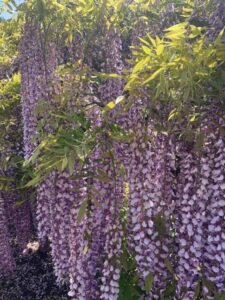 The other most impressive attractions during the wisteria season dubbed the “Great Wisteria Festival” are an 80-meter-long tunnel covered in white fuji flowers, and a second tunnel covered in yellow laburnum flowers.
The other most impressive attractions during the wisteria season dubbed the “Great Wisteria Festival” are an 80-meter-long tunnel covered in white fuji flowers, and a second tunnel covered in yellow laburnum flowers.
Because Wisteria is the park’s main attraction, you may be caught off guard by the increased entrance fee. We paid 1,600 yen when we visited that day, twice the amount from the previous season. Thankfully due to the magnificence and beauty of the wisteria, we were not disappointed.
Winter Season
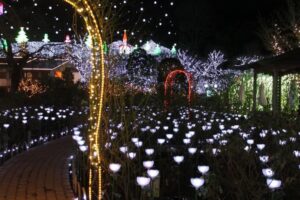 During winter season, all the flowers are replaced with illuminating lights. Before the pandemic happened, we would annually visit this place with my family. It’s still worth the trip; just be sure to exercise caution when there are crowds.
During winter season, all the flowers are replaced with illuminating lights. Before the pandemic happened, we would annually visit this place with my family. It’s still worth the trip; just be sure to exercise caution when there are crowds.
Also, be sure to prepare yourselves with how cold it will get. During winter the entrance fee is back down to 600-800 yen. We’ll make sure to visit again and experience their beautiful illumination lights!
Tips for Visitors to Ashikaga Flower Park
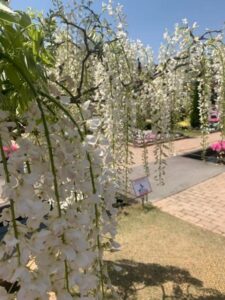 • To reach Ashikaga Flower Park from Tokyo, first take a Shinkansen to Oyama station, making sure you take a train that stops there. Then you need to transfer to the JR Ryomo Line and travel to Ashikaga Flower Park Station, just outside the park. The whole trip can run you just under 5,000 yen one way from Tokyo. It’s a good deal if you have access to the JR Pass. If not, you can cut the price almost in half taking a slower train. This will result in a longer trip though.
• To reach Ashikaga Flower Park from Tokyo, first take a Shinkansen to Oyama station, making sure you take a train that stops there. Then you need to transfer to the JR Ryomo Line and travel to Ashikaga Flower Park Station, just outside the park. The whole trip can run you just under 5,000 yen one way from Tokyo. It’s a good deal if you have access to the JR Pass. If not, you can cut the price almost in half taking a slower train. This will result in a longer trip though.
• Most of the year, the opening hours of the park are from 9:00 to 18:00. However during winter hours, they are reduced to 10:00 to 17:00. During the Great Wisteria Festival (peak wisteria season) they’re extended to 7:00 to 21:00.
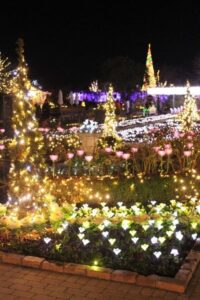 • Just as opening hours vary during the year, so too do the entry fees to the park. In fact, the admission fees can even differ from one week to the next! The range is from 300 to 1,800 yen depending on season
• Just as opening hours vary during the year, so too do the entry fees to the park. In fact, the admission fees can even differ from one week to the next! The range is from 300 to 1,800 yen depending on season
• If you’re not content with just looking at the wisteria, you can even see what it tastes like by buying a purple Fuji Ice Cream flavored with the flower!
• Be sure to keep your past admission tickets, so the next time you visit, you can get a 200 yen discount!
You can also visit their website for more information!
You can visit Ashikaga. Or you can live there! Find out more about being an Assistant Language Teacher today!
Image Credits:
Cover Image: k*****************mさん on PhotoAC
All other images were provided by the original author and are Ⓒ MUSUBI by Borderlink
Top photo: 古館ぶたこさん on PhotoAC
In the last few years, we have all experienced the seemingly never-ending doom and gloom of Covid-19. For those of us in Japan that’s mainly been states of emergency, partial lockdowns and some teleworking. With the roller coaster ride that it’s been, it has surely added a lot of stress to everyone’s day-to-day lives.
We wrote about how things were in Japan back in 2020. In the time since, some things have changed for the better, while others remain the same. Here, we will be looking at some of the preventative measures offered by health organizations as we proceed with our lives in this new abnormal normality.
Social Distancing
A rather obvious one that has been instilled in us from the beginning. Avoid any heavily populated areas as much as possible and keep your distance from people. Especially the ones that don’t even know how to properly wear a mask. I know for those travelling to work it is near impossible with packed trains in the metro areas, but nevertheless, be aware of your surroundings. The WHO website recommends to avoid the 3C’s which include avoiding spaces that are closed, crowded, and involve close contact.
Masks
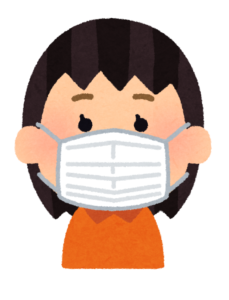 Whether it be the generic white mask purchased at a local drug store, or cloth that can be washed and re-used, proper mask wear can help protect against the spread of the virus.
Whether it be the generic white mask purchased at a local drug store, or cloth that can be washed and re-used, proper mask wear can help protect against the spread of the virus.
Personally, it’s easy to want to re-use a mask day in and day out because it’s available, but it is recommended to change every day or if you have the cloth version to wash after use. According to the World Health Organization, it is recommended to keep your mask in a plastic bag when not being used. Although you may have seen people doing this, according to Toyohashi University of Technology, wearing two masks has the same effect as wearing one, so don’t go overboard because it’s unnecessary.
Travel
For the most part, trains in Japan are doing a good job at regulating air flow per train car. Although it is still a little chilly at times, they have windows open, and there is a ventilation system that regulates air flow in and out of the train cars every 6 to 8 minutes. The train companies recommend avoiding rush hour, but that is a far-fetched idea that for most people is not doable.
What to do if you feel unwell
According to multiple health organizations both international and domestic, these steps should be taken:
If you have a fever, cough and difficulty breathing, seek medical attention immediately. Call by telephone first and follow the directions of your local health authority.
Know the full range of symptoms of COVID-19. The most common symptoms of COVID-19 are fever, dry cough, tiredness and loss of taste or smell. Less common symptoms include aches and pains, headache, sore throat, red or irritated eyes, diarrhea, a skin rash or discoloration of fingers or toes.
Stay home and self-isolate for 10 days from symptom onset, plus three days after symptoms cease. Call your health care provider or hotline for advice. Have someone bring you supplies. If you need to leave your house or have someone near you, wear a properly fitted mask to avoid infecting others.
Keep up to date on the latest information from trusted sources, such as WHO or your local and national health authorities. Local and national authorities and public health units are best placed to advise on what people in your area should be doing to protect themselves.
Another thing you can do is contact your city/ward offices’ health insurance office.
PCR Tests
Depending on where you live, PCR same-day tests are easily accessible. In the metropolitan areas, there are testing areas that provide results in hours. They tend to cost around 3,000 yen, but if you contact your ward/city office you might be able to find a local clinic that offers them for a cheaper price.
Even more so, recently there are clinics that offer real-time test results for PCR for local use only. The PCR test for traveling overseas will cost you close to 20,000 yen and the results are also within a few hours.
Although trying to go about your daily life, it can be near impossible to avoid coming into contact with people, please be aware of your surroundings and try to keep yourself as safe as possible. There’s no telling what kind of symptoms you will get if infected by the virus and it’s better not to play with fire unless necessary. I hope you all have a virus-free 2022 and get through it with no issues.
Photo Credits:
Top photo: 古館ぶたこさん on PhotoAC
Additional image courtesy of Irasutoya
All other content (text) created by the original author (Antonio Diaz) and © 2022 MUSUBI by Borderlink
I am addicted to mountain climbing. Japan is covered in mountains and hills, and Japanese people love to climb them. In recent years, there has even been a “climbing boom” as more and more take up the hobby. I have climbed 32 of the 100 Famous Mountains of Japan, and plenty of those that make up the next 200-300 most famous. I am determined to reach all the summit of all of the 100 Famous Mountains though!
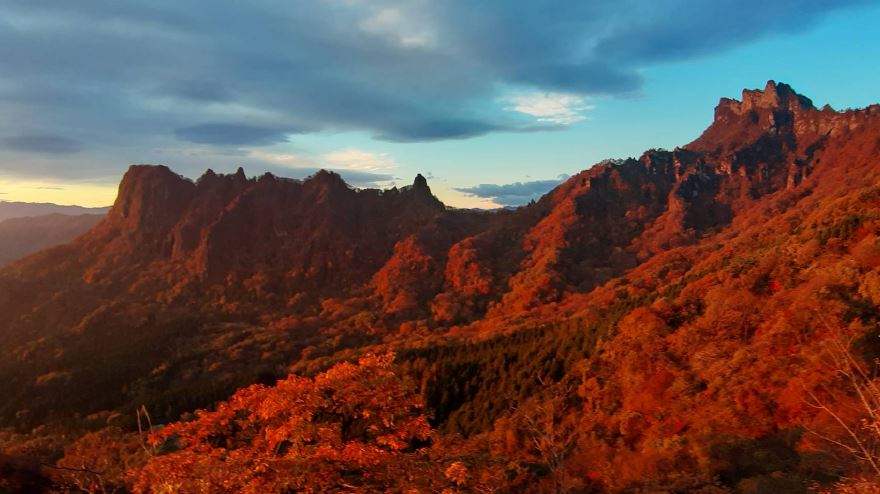
100 Famous What Now?
Actually, “100 Famous Japanese Mountains” (日本百名山, Nihon Hyaku-meizan) is a book written in 1964 by Kyūya Fukada, a mountaineer who climbed most of the mountains in Japan. Mr. Fukada selected 100 celebrated Japanese mountains based on a combination of grace, history, and individuality.
Moreover, he excluded mountains with an altitude of less than 1,500 meters. In other words, the best of the best! Nowadays, the 100 list has become widely known, and more and more people have chosen mountains from the book to climb. Including yours truly!
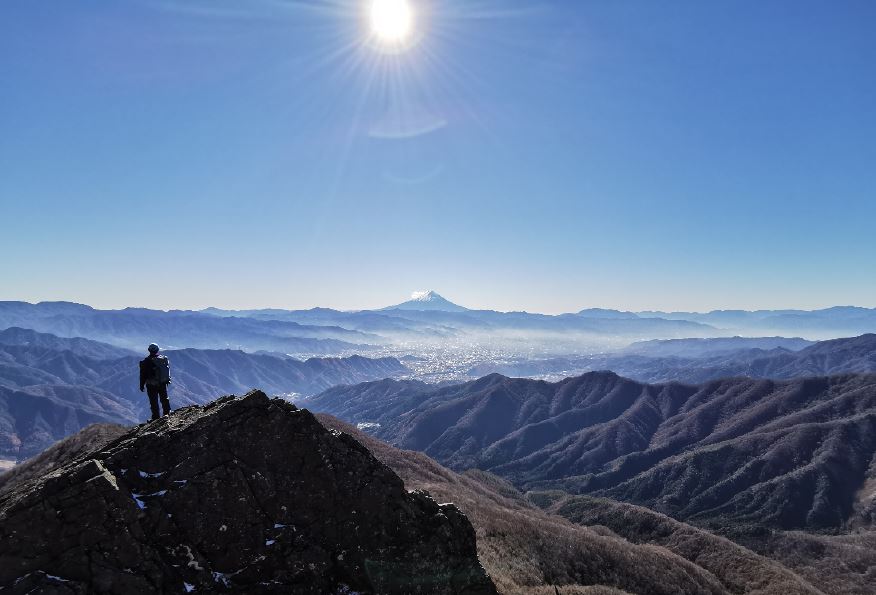
Mountain Recommendations
Unlike the famous Himalayas, Japanese mountains are not very difficult to reach the summits of. In general, they are not that big, but there’s plenty of beautiful scenery to enjoy along the way! One of my favorite mountains is Mount Chokai in Yamagata Prefecture. Escaping to Mt.Chokai can be an excellent way to get out amongst nature.
Climbing to the peak and back took me 12 hours. However, you do not have to hike all the way to the peak. Around half-way up the mountain there is Chokai Lake, a great destination for a more casual hike.
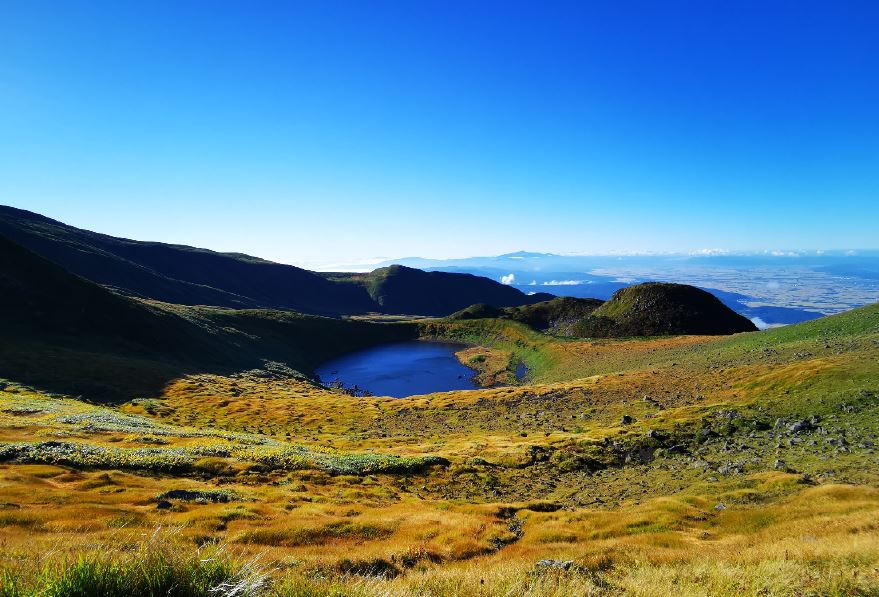
I also love Mount Akatake of the Yatsugatake Mountains, which is closer to Tokyo. I stayed at the lodge on the peak and enjoyed a wonderful sunrise. Besides the excellent scenery, the lodge is clean and the food is delicious too.
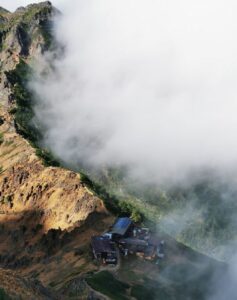 If you want to explore another mountain near Tokyo, I recommend Mt. Kumotori, which is
If you want to explore another mountain near Tokyo, I recommend Mt. Kumotori, which is
the highest peak in the Tokyo area, and Mount Tanzawa in Kanagawa. Both of them take about 4 hours to reach the peak, but the routes are easy to walk.
Words are not enough to describe these beautiful mountains. Mountains are everywhere in Japan. When you have time, go and climb one!
Photo Credits:
All other photos were provided by the original author (Fang Guo)
All other content (text) created by the original author and © 2022 MUSUBI by Borderlink
Here at MUSUBI, we love ramen. We like it a lot. So here’s yet another article about ramen, with a slightly different perspective (and hopefully some new facts)!
Ramen is a Japanese food that many around the world are acquainted with. Almost everyone with an interest in Japanese cooking has or will have it at some point in their lives. Yet few know just how deep the culture of ramen truly runs. It goes well beyond the plain packed instant noodles, with many varieties and flavors. And, much like cultural dishes in many countries, various parts of Japan developed their own local styles.
What Is Ramen?
Ramen is Chinese-style wheat noodles in a thick, hearty broth. It has various toppings such as chashu (pork), nori (sea weed), menma (lacto-fermented bamboo) and naruto (fish cake). There are endless variations of toppings, broth types, and even how soft the noodles are. It’s not incorrect to say that there is likely a ramen for everyone out there!
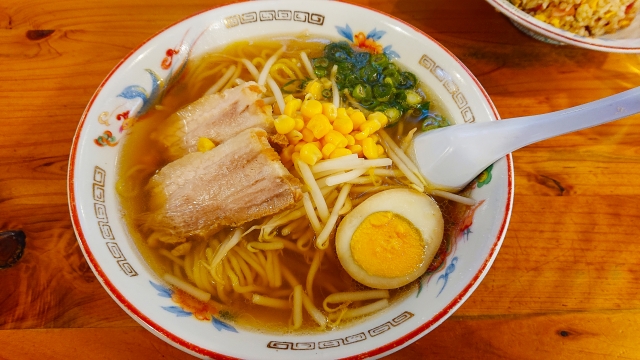
History of Ramen
Ramen was introduced to Japan in the late 19th century or early 20th century by the Chinese living in Yokohama. The first ramen restaurant, called “Rairaiken” opened in Asakusa in 1910. Ramen was called shina-soba or Chinese Soba until about 1950, but nowadays it is known simply as Ramen.
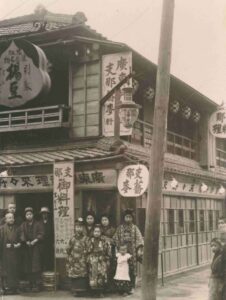 Ramen became popular after World War 2. In 1945 there was a rice shortage due to a poor harvest and the Americans brought in wheat flour to help reduce the food shortages. This wheat flour was used to make bread and noodles, and the popularity of ramen increased. Up until 1950 wheat flour was rationed, but after that it became freely available. Many ramen shops started to open in the early 1950’s. In 1958, instant ramen was introduced by the Nissin Food company and its popularity boomed.
Ramen became popular after World War 2. In 1945 there was a rice shortage due to a poor harvest and the Americans brought in wheat flour to help reduce the food shortages. This wheat flour was used to make bread and noodles, and the popularity of ramen increased. Up until 1950 wheat flour was rationed, but after that it became freely available. Many ramen shops started to open in the early 1950’s. In 1958, instant ramen was introduced by the Nissin Food company and its popularity boomed.
Nowadays, Ramen is an iconic part of Japanese food culture, and ramen shops are in every city, town and village in Japan.
All Kinds of Flavors
I was first introduced to ramen by a certain fun-loving ninja who just happens to share the first name of a popular ramen topping. Yes, that’s right: Naruto Uzamaki. By the way, Naruto is a really good manga and anime and I highly recommend that you watch it if you haven’t already.
When it comes to Ramen broth, four flavors of broth stand out as the most popular: Shio (salt-based) Tonkotusu (pork bone-based) Shoyu (soy-based) and Miso (miso paste-based). There are other others, such as curry and tomato, but those are the big four.
As I said earlier, many areas in Japan have their own distinctive variety. A couple of the most well-known are:
Sapporo Ramen – from Hokkaido. It has a broth made from miso paste and usually has seafood toppings. Hokkaido is famous for its fresh sea food.
Hakatta Ramen – from Kyushu. This tonkotsu type is made from pork bones and has a thick, rich and delicious broth.
Tokyo Ramen – the broth of Japan’s capital is made from soy sauce, and easy to recreate yourself.
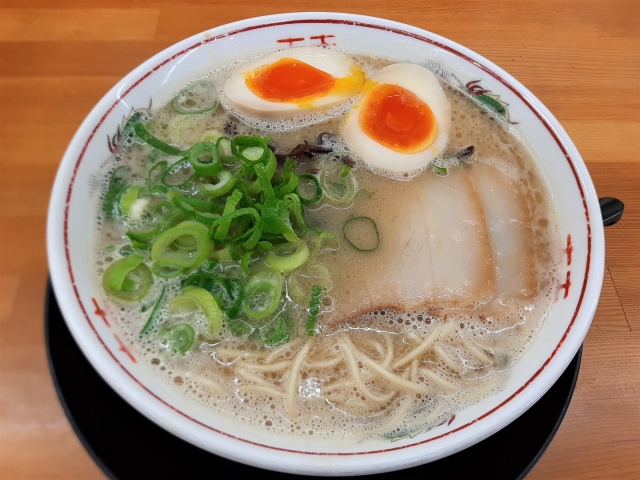
The Yokohama Ramen Museum
Do you want to find out even more about ramen? Then I highly recommend a visit to the Shin-Yokohama Ramen Museum in Yokohama. Its only 50 minutes by train from Tokyo Station. You can find out more about the history of ramen, and there’s 9 ramen restaurants, each one from a different region of Japan.
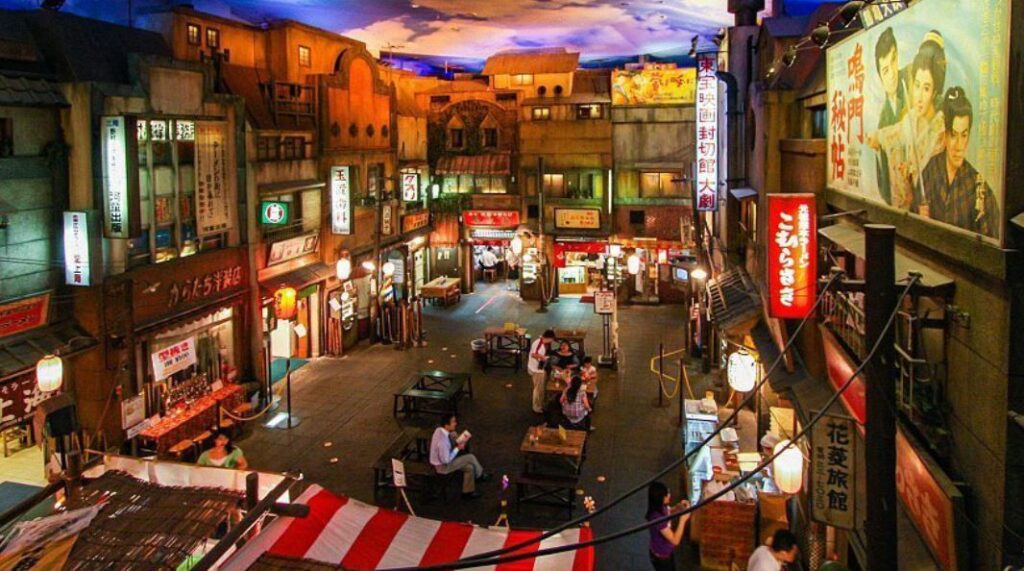
The museum is modelled to look like 1950’s Japan and has a really cool vibe. Each restaurant also serve mini portions so you can try out each type of ramen. Admission is 380 yen and it’s open daily from 11 am to 10 pm. The website also has an English option.
I hope that when you’re in Japan, you’ll remember to check out some local ramen. It’s super tasty! Thanks for reading!
Image Credits:
Cover Image: YUTO@PHOTOGRAPHERさん on PhotoAC
Image 1 sai10さん on PhotoAC
Image 3 zousanさん on PhotoAC
Other images courtesy of the Shin-Yokohama Ramen Museum
All other content provided by the original author
Being from the UK, I have been subjected to many-a-trip to a creaky old castle. And let me tell you, every trip was as boring and grey as the buildings I was forced to visit. Sometimes we had to go to these “partial” or ruined castles that had nothing in them. They were just some stones in the ground and a few walls. Not exactly a thrill seeker’s paradise.
 Many of my childhood trips were spent wandering around places like the one to the left. My dad excitedly going around looking at the historic artifacts. The tour guides telling stories of kings and queens. Me dragging my feet, wondering why I couldn’t be at home playing on my PlayStation 2. School trips too! Even the excitement of being out of school for a day was ruined when the realization hit. We were just being dragged around a castle for history class.
Many of my childhood trips were spent wandering around places like the one to the left. My dad excitedly going around looking at the historic artifacts. The tour guides telling stories of kings and queens. Me dragging my feet, wondering why I couldn’t be at home playing on my PlayStation 2. School trips too! Even the excitement of being out of school for a day was ruined when the realization hit. We were just being dragged around a castle for history class.
I know, first world problems! There’s a lot worse to experience in life than a boring trip to an old building. But, long ramble short, I just never had an interest or engagement with castles or their histories. It bored me.
That feeling would change when I experienced not just a Japanese castle, but THE Japanese castle.
The Road to Himeji Castle
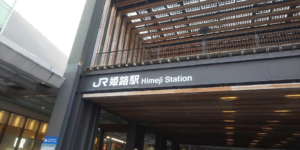 To make this trip extra special, I had my first experience on the Shinkansen (新幹線). It was fascinating to me that you could so easily get tickets from a machine, especially for such long journey. A ticket to Himeji from Tokyo Station is around 22,000円 for a weekday ticket.
To make this trip extra special, I had my first experience on the Shinkansen (新幹線). It was fascinating to me that you could so easily get tickets from a machine, especially for such long journey. A ticket to Himeji from Tokyo Station is around 22,000円 for a weekday ticket.
The process was simple and easy, and the machines offered a variety of language options. Staff were available for support, but buying the tickets and jumping onto the next train was as simple as could be.
Pro tip! If you want a faster journey, take the Nozomi (のぞみ) train. On the way to Himeji, sit on the right side so you can see Mt. Fuji pass by. (Unlike me, who sat on the left side of train, so sorry no pictures!)
And, like that, three and a half hours later; I was at Himeji station with this on the horizon:
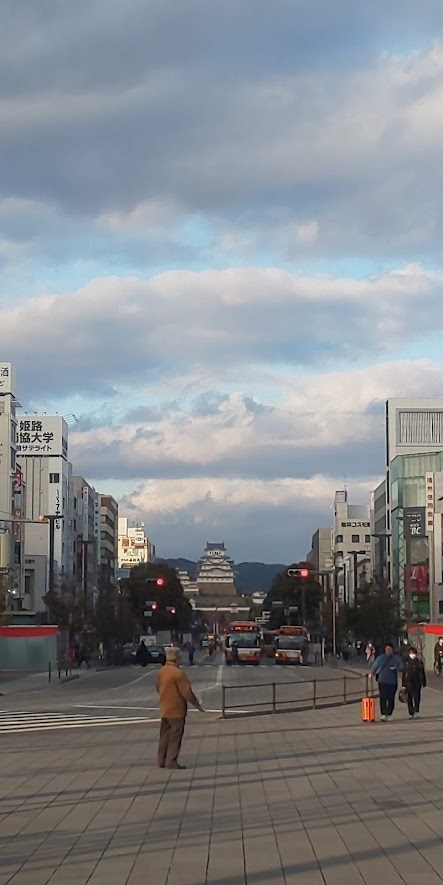
The Castle
After a relaxing evening at an izakaya and a much-needed rest at the hotel, the next day was castle time!
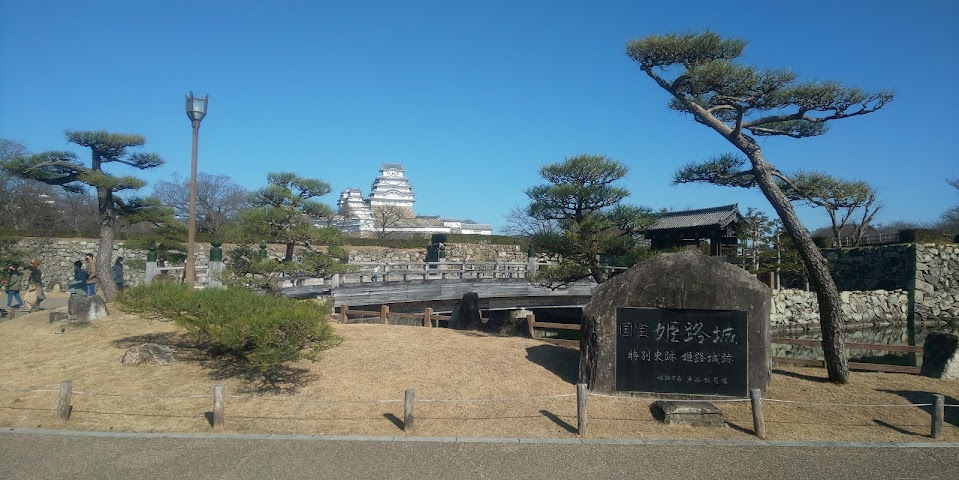
8-year-old me would be disgusted with older me! 20 years later and I’m here gawping at a castle. Even from a distance, it leaves such a striking image. The size of the grounds is immense. Attached to the grounds is a zoo for animal lovers. I didn’t get a chance to go to the zoo, but I was assured it was a good visit.
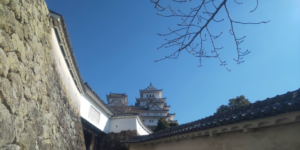 Tickets to the main keep are 1,800円. For 400円 extra, you can get access to the gardens about 5 minutes down the street from the main entrance. Highly recommend the gardens! But, that will come later.
Tickets to the main keep are 1,800円. For 400円 extra, you can get access to the gardens about 5 minutes down the street from the main entrance. Highly recommend the gardens! But, that will come later.
The castle is 6 floors, and each level offers some amazing sights of Himeji and the surrounding countryside.
 The architecture is beautiful and the grandeur of the castle is always there. It’s rather breath-taking. One warning though, the doorways and stair ways get a little steep and low. Tall people beware! You’re in for a limbo session.
The architecture is beautiful and the grandeur of the castle is always there. It’s rather breath-taking. One warning though, the doorways and stair ways get a little steep and low. Tall people beware! You’re in for a limbo session.
There are some ancient artifacts too, and some interesting historical facts that I’ll leave you to discover on your own trip! Everything has a translation for every language, so wherever your from, you’re welcome to explore.
The Gardens
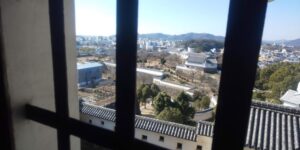 For me, the majesty of the castle was already mind-blowing. The rich history of the castle and Himeji are laid bare within its walls. But, on such a sunny and clear winter’s day, the place to go was the gardens.
For me, the majesty of the castle was already mind-blowing. The rich history of the castle and Himeji are laid bare within its walls. But, on such a sunny and clear winter’s day, the place to go was the gardens.
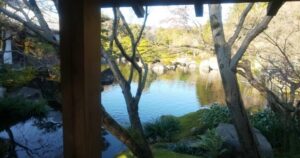 The pictures speak for themselves. The expansive water features, beautiful architecture, and peace and quiet. A far cry from the hustle and bustle of the city life I’m used to in Tokyo! It’s worth going beyond the big city though!
The pictures speak for themselves. The expansive water features, beautiful architecture, and peace and quiet. A far cry from the hustle and bustle of the city life I’m used to in Tokyo! It’s worth going beyond the big city though!
The gardens have it all: Bamboo groves, lantern lightings in the spring and autumn, and some beautiful greenery. There’s also flower gardens and sakura or cherry blossoms. The castle gardens are a must for any and every season.
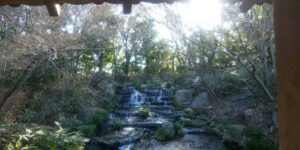 The best way to experience a country is through its history. As someone who was very opposed to history and thought looking through old buildings was a boring chore, Himeji castle broke my expectations. It ended up being a fun adventure and a deep historic look at Japan.
The best way to experience a country is through its history. As someone who was very opposed to history and thought looking through old buildings was a boring chore, Himeji castle broke my expectations. It ended up being a fun adventure and a deep historic look at Japan.
Take the Trip Today!
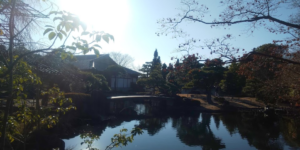 If you’re interested in Japan and its culture, Himeji Castle is a must. As a cultural World Heritage site, and a major part of Japan’s history, I leave you to discover the wonder and majesty of the grounds and beauty of the architecture.
If you’re interested in Japan and its culture, Himeji Castle is a must. As a cultural World Heritage site, and a major part of Japan’s history, I leave you to discover the wonder and majesty of the grounds and beauty of the architecture.
Plus, being in the Kansai region, the food is to die for, with Octopus balls (たこ焼き), Okonomiyaki (お好み焼き) being some major regional dishes to discover on your journeys.
And, it’s a great way to enjoy the modern convenience of Japan with the Shinkansen! 3 and half hours in a relatively inexpensive and relaxed way. It’s a great experience all round and a fantastic way to spend a weekend!
Image Credits:
Cover Image: 七彩さん on PhotoAC
1 (European castle photo) 終末旅行者さん on PhotoAC
All other images were provided by the original author and are Ⓒ MUSUBI by Borderlink
Previously on MUSUBI, we shared where to get some great authentic tacos in Tokyo. But what about Japan’s own Second City (apologies to Yokohama), that culinary and cultural capital called Osaka?
For those living in Osaka and looking for some good Mexican cuisine, you’re in luck. There is a place that’s just a stone’s throw from Osaka Castle Park. It’s called Avocados Mexican Cafe. It’s a recent addition to the up-and-coming Mexican cuisine scene in this place I call home. But in that short time it has already proven to be one of the best.
Great Food
You can get all the classic Mexican dishes here for a fairly decent price. There’s burritos, quesadillas, and of course, tacos. These come individually or in sets. There’s plenty of sides, and plenty of great drinks as as well. Perhaps best of all is the Special Menu, which has some unique items. Guacamole toast, fish salad, old-fashioned gratin- it’s all here waiting for you to try! Dine-in and take-out are both available.
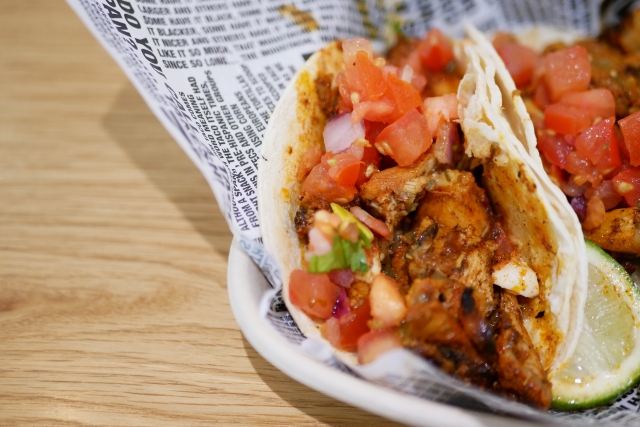
The menu consists of everything you would typical find at a Mexican restaurant in Japan and then some. But Avacados also specializes in being a café. So if you are just wanting to stop by and relax with a cup of Caffè Americano, they have you covered. I especially recommend the homemade carrot cake, although be aware that it’s a hot item and tends to sell out quickly!

Great Service
Even better than the food are the people behind it. The owner comes straight from the homeland, making this just about as authentic a Mexican dining experience as you can get. Avacadaos is run by a native of Cancun, and many items are handmade on the spot with a variety of authentic ingredients. If you’re lucky enough to go at the right time, you may get to try an item that’s not on the regular menu yet. Avacaods is always looking to create some new and exciting twists on traditional favorites.
The staff are very friendly and many are well-versed in English. If you have concerns about allergies or certain ingredients, just let them know and they’re more than happy to leave them out. And the interior of Avacados is as homey and comfortable as it gets. You may forget you’re still in Osaka until you step outside again!
Whether it be tacos, burritos, coffee or cakes, you can find everything you need. Whether it be a full meal or a relaxing snack, this is a great place to visit after a trip out around the city.

Avocados Mexican Cafe highly recommended. Boasting many 5-star reviews by diners on Google, it should be on anyone’s destination for some find Mexican dining.
Check it out next time you’re in Osaka. And tell ‘em we sent you!
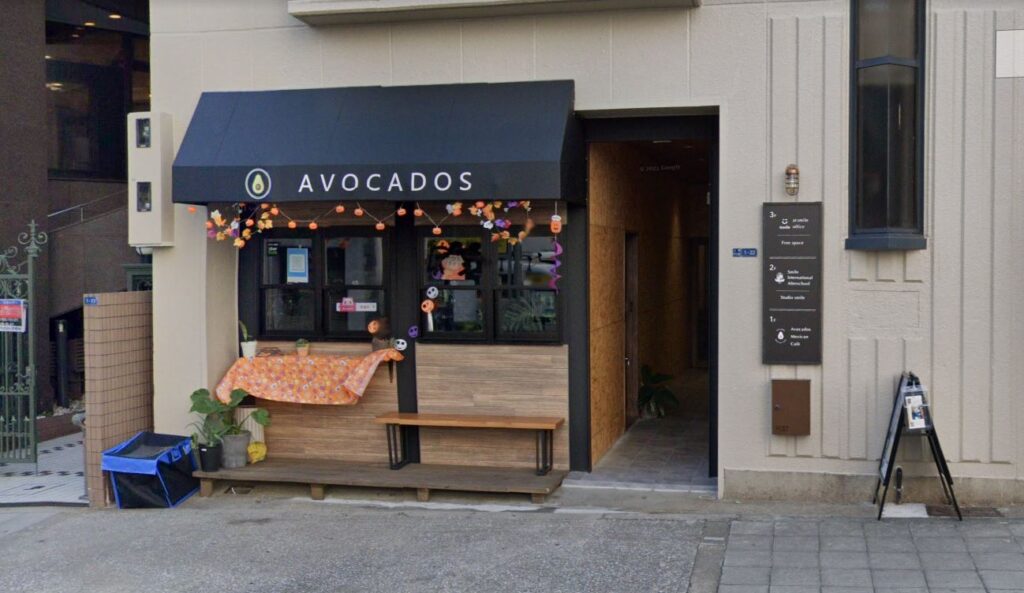
Image Credits:
Cover Image: まぽさん on PhotoAC
1 ALBISさん on PhotoAC
2 samuelfernandezriveraさん on Pixabay
3 心に響く♥癒やしの写真館☆Meg’s☆さんon PhotoAC
4 – Google Maps
All other content provided by the original author
Ok, I apologize; I have deceived you. As you might have guessed, there is no quick and easy way to learn Japanese. It is undeniably a difficult language to learn. In fact, if English is your first language, then Japanese is usually ranked in the top 10, sometimes even the number 1 , most difficult languages to learn. Also, there are very few native Japanese speakers outside of Japan – only 7 million in the rest of the world. It’s difficult to practice before coming to the country. And unless you go into translation, not much use once you leave.
But don’t despair! It is still possible to learn Japanese and reach whatever standard you’re going for. Whether that means ordering in a restaurant, having conversations with friends or watching a TV show. Just because it’s not easy, doesn’t mean that you can’t try to find the best path to learning. So here are some tips, hints, tricks and warnings about how to find convenient ways to learn and practice Japanese that best suit you.
But First: Why?
Before we leap into the wild and confusing world of the language itself, or the forest of different learning options, let’s take a look at why we might want to study Japanese in the first place. There are plenty of things to consider. Aside from some of the more obvious reasons, a really important one is that learning a language helps you to teach. Not only does it set a good example for your students and fellow teachers, that you’re actually making the effort to learn a language yourself, but it helps you understand the process.
A more obvious reason is that it will help you make the most out of living in Japan. It’s of course handy to get by in day to day life, but also, there are few things more satisfying than making new friends and speaking with them in your new language – no matter how basic your conversations may be at first. Moments like that can open your eyes to a whole new culture. There are plenty of other personal benefits. Learning a new language is great brain training, and it will give you new skills to learn lots of other things too.
Ultimately, and this is perhaps the most important thing, it can be fun. If you can turn it into a game, or a relaxing activity, it can be really rewarding. The enthusiasm you gain can be something you can pass onto your students and make work more enjoyable and fulfilling too.
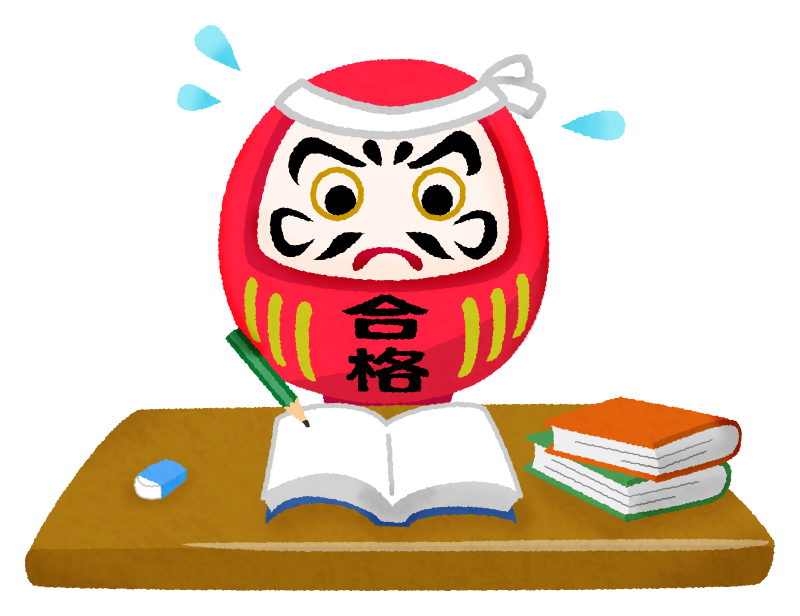
Courtesy of Japaclip https://japaclip.com/en/daruma-studying-for-entrance-exam/
The Basics of Speaking/Listening
I have to make another confession. I’m no Japanese language expert. I’ve been learning since I arrived in Japan, about two years ago. In that time I have just managed to pass the Japanese Language Proficiency Test, N5, the most basic level. However, there are some interesting details about Japanese that are good to know if you’re a complete beginner.
 First off, the good news: it’s not all difficult. Basic pronunciation is actually quite easy for an English speaker. There are not many sounds in Japanese that we don’t have in English, unlike in Russian, Arabic or Chinese for example. All words are generally made up of small groups of consonants and vowels, for example; ka, ki, ku, ke, ko, ta, ti, tu, te to.
First off, the good news: it’s not all difficult. Basic pronunciation is actually quite easy for an English speaker. There are not many sounds in Japanese that we don’t have in English, unlike in Russian, Arabic or Chinese for example. All words are generally made up of small groups of consonants and vowels, for example; ka, ki, ku, ke, ko, ta, ti, tu, te to.
There as some exceptions like ‘n’, but not many. There’s a few sounds that are a bit tricky, like ‘r’ being somewhere between the sound of ‘r’ and ‘l’ in English. If you immerse yourself in listening to a lot of Japanese you should be able to pick it up ok.
The Basics of Writing/Reading
The next easy thing is; there’s no spelling. Everything in Japanese is phonetic, it is read exactly as it is shown on the page – well, almost. The writing system starts off easy. The first two writing systems, Hiragana and Katakana, are a bunch of symbols, each of which has their own sound. There are 46 of these each, or 71 if you include special combinations. Once you’ve learned all of these, you should in theory be able to read anything.
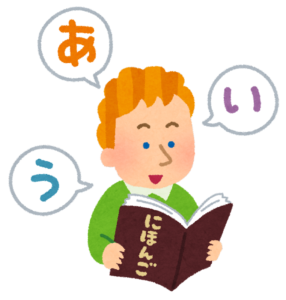 Unfortunately it’s not quite that simple. There are also over 50,000 kanji, or Chinese characters. These are admittedly a bit of a nightmare, but you can get by with the first 1,000 most commonly-used ones. Most native Japanese speakers don’t know anywhere near all of them. That said, I’m not going to sugar coat it; they are difficult to learn. Each kanji has at least two different readings and they can be really difficult to remember and distinguish. It takes time, but it’s worth the effort. Learning anywhere between 1-5 a day is easily attainable. And you can start with these five!
Unfortunately it’s not quite that simple. There are also over 50,000 kanji, or Chinese characters. These are admittedly a bit of a nightmare, but you can get by with the first 1,000 most commonly-used ones. Most native Japanese speakers don’t know anywhere near all of them. That said, I’m not going to sugar coat it; they are difficult to learn. Each kanji has at least two different readings and they can be really difficult to remember and distinguish. It takes time, but it’s worth the effort. Learning anywhere between 1-5 a day is easily attainable. And you can start with these five!
Learning it the New Way
So, that all seems a bit daunting, right? Luckily, as Japanese is a relatively popular language to learn nowadays (almost 4 million learners ), there are plenty of handy tools out there to help you learn. My biggest single piece of advice is to first find a language learning app. There are many to choose from, and everyone has different preferences for what works for them. Try and find one that works for you.
Whilst each one may have a different approach, as long as it helps you do even a tiny bit of daily practice, they can all be helpful. Some of the most popular ones are Pimsleur Japanese, JA Sensei, Human Japanese, HelloTalk, Duolingo, and WaniKani. Have a search and see which ones you like. There are also plenty of YouTube channels for a wide range of abilities; I especially recommend Japanese Pod 101 and JapaneseAmmo. There are plenty of websites to choose from too.
Learning it Old-School
 All these new technological ways of learning are all well and good, but let’s not forget some of the tried and tested traditional methods. When it comes to textbooks, there are many different things to consider and a bewildering array of choice too. Genki is probably the most popular and well-known, but there are plenty of others to choose from too. There’s Japanese from Zero for beginners or Minna no Nihongo (“Japanese for Everyone”) for a more thorough guide.
All these new technological ways of learning are all well and good, but let’s not forget some of the tried and tested traditional methods. When it comes to textbooks, there are many different things to consider and a bewildering array of choice too. Genki is probably the most popular and well-known, but there are plenty of others to choose from too. There’s Japanese from Zero for beginners or Minna no Nihongo (“Japanese for Everyone”) for a more thorough guide.
Of course, nothing beats a real lesson. If you’re lucky, you might be able to find some at a local community center. You can look online at websites like italki, where you can pay to have an online lesson with a teacher or a native speaker. If you can’t find a native speaker to practice with online, try immersing yourself in the language through TV, films, music, anime. Even better, get out there and meet people!
In Conclusion (For Now)
Overall, remember that learning Japanese needn’t be a terrifying and impossible scary task. Take control of it, do your research and have fun! You’ll be surprised just how quickly you can start learning and how satisfying it will be when you do. Your journey has only just begun, and there’s much more to come. But for now, you can take the first step!
Image Credits:
Cover Photo by Dhafin Kumarajati on Unsplash
1 – Copyright Japaclip.com (used under ‘Terms of Use’ permission)
Top Photo by 663highland used under Creative Commons Attribution-Share Alike 3.0 Unported
Looking for a place to get away from the city life? Here’s the perfect city for sunny or gloomy weather! At the southern tip of the Izu Peninsula, a home to famous hot springs and beautiful beaches, lies the coastal city of Shimoda. You can get there by a few hours’ of drive or train ride from Tokyo. Here are some things to get excited about this place:
In Hot Days
Those residing around Tokyo generally want to skip the long-distance travel to beaches away from the city. Shimoda offers plenty of beach space for you to enjoy at a reasonable distance! There’s also marine sports and swimming opportunities to relieve yourself from the scorching summer in Japan. The official swimming season extends from mid-summer to early fall.
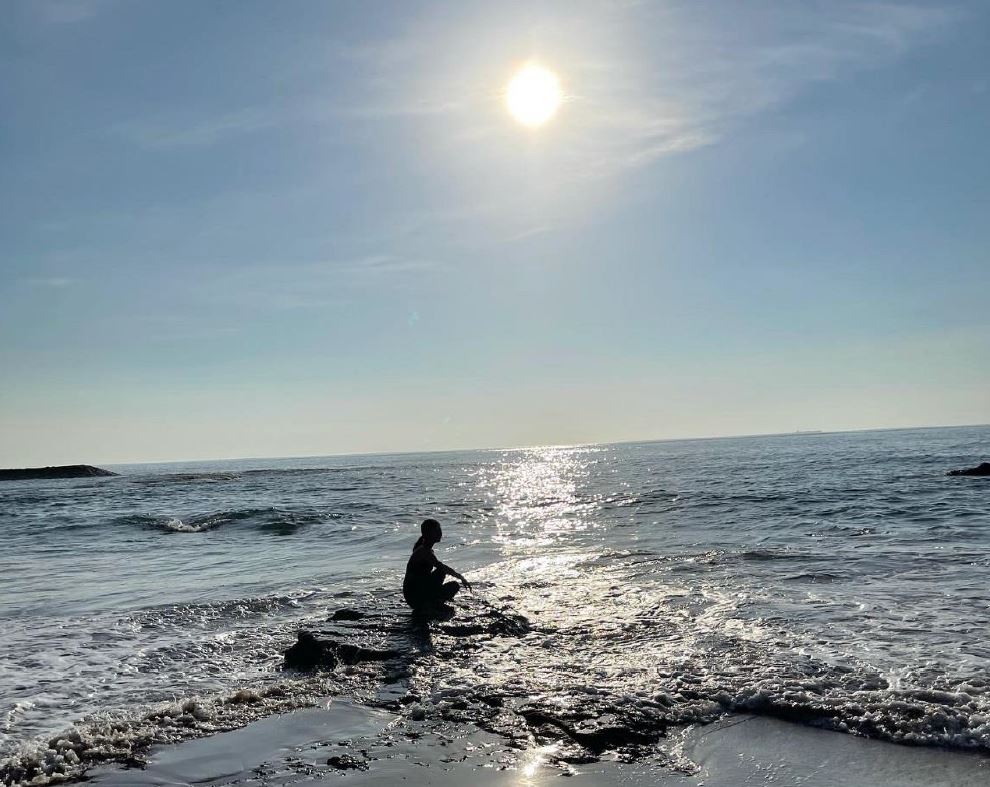
If you are looking for a convenient & popular beach to visit, you can’t go wrong with Shirahama Beach. It is 5 kilometers away from Izukyu-Shimoda Station. It’s also close to some convenience stores and beach gear rental shops. While you’re trying to cool off, why not grab some Kakigōri?
In Cold Days
Located just in front of Shirahama Beach is Hotel Izukyu. Here you can relax in an open-air bath (Ryujin no Yu) or in a large bath (Rendaiji no Yu) hot spring. You can find them at Rendai-ji Onsen, one of the four (Rendai-ji, Kawachi, Shirahama, Kannon) hot springs within Shimoda.
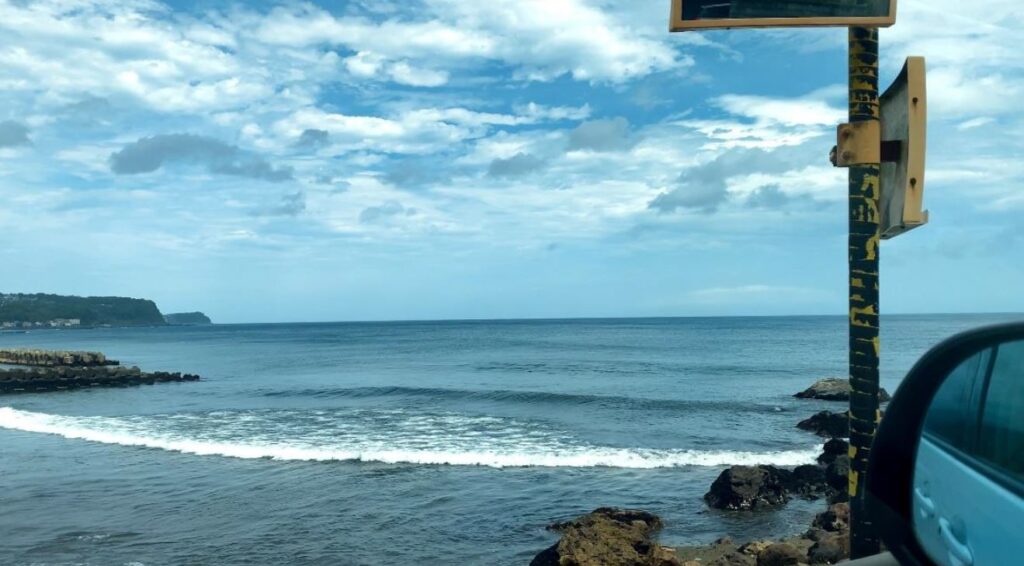
If you are not able to experience of these hot springs, cheer up! Shimoda has foot baths or ashi-yu facilities around the city for free. And, one of these can be found right in front of Izukyu-Shimoda Station.
Seafood
And, if we are talking about seafood, the Japanese red snapper or kinmedai is a must-try. The city takes pride in having the largest catch of kinmedai all over Japan. Also, I would like to recommend Kinmeya, a restaurant located at Higashihongo, Shimoda.
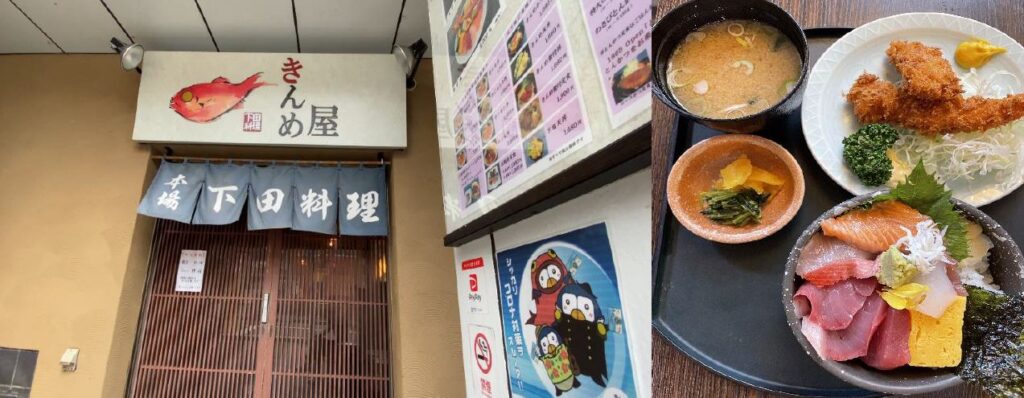
The city alone has a lot to offer. And there’s even more if we look at the whole Izu Peninsula of Shizuoka. Indeed, the Land of the Rising has never ceased to leave me in awe. When you’re here, grab your chance to enjoy and explore it!
Photo Credits & Information:
Information on Hotel Izukyu’s Hot springs – https://www.hotel-izukyu.co.jp/
Additional Photographs
Top Photo by 663highland used under Creative Commons Attribution-Share Alike 3.0 Unported
All other images were provided by the original author and used with permission
All other content (text) created by the original author and © 2022 MUSUBI by Borderlink
